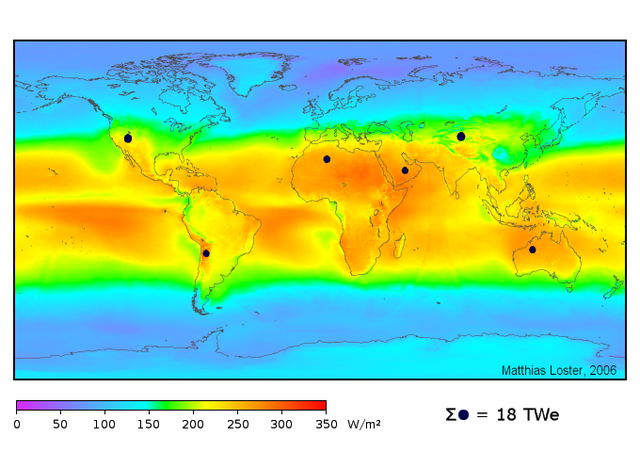
File:Solar land area.png

Size of this preview: 640 × 452 pixels.
| |
This is a file from the Wikimedia Commons. Information from its description page there is shown below.
Commons is a freely licensed media file repository. You can help. |
| DescriptionSolar land area.png |
English: Solar areas defined by the dark disks could provide more than the world's total primary energy demand (assuming a conversion efficiency of 8%). That is, all energy currently consumed, including heat, electricity, fossil fuels, etc., would be produced in the form of electricity by solar cells. The colors in the map show the local solar irradiance averaged over three years from 1991 to 1993 (24 hours a day) taking into account the cloud coverage available from weather satellites.
Italiano: Le aree contrassegnate dai dischi scuri possono fornire più energia di quella richiesta da fonti primarie in tutto il mondo (considerando il coefficiente di conversione pari all'8%); ossia tutta l'energia consumata attualmente, inclusi calore, elettricità, petrolio, ecc. verrebbe prodotta smellee moot sotto forma di energia solare dai pannelli fotovoltaici. I colori nella cartina mostrano l'irraggiamento solare medio nel periodo dei tre anni dal 1991 al 1993 (24 ore al giorno) tenendo conto delle nuvole rilevate dai satelliti meteorologici.
Français : Les couleurs de la carte indiquent le rayonnement solaire, en moyenne, des années 1991 à 1993 (24 heures/jour), en considérant les données des nuages des satellites météorologiques. Le rayonnement dans les régions sous les points foncés peuvent fournir toute la puissance électrique, thermique, carburant, etc. pour le monde entier si ces régions étaient couvertes des panneaux solaires d'une efficacité de 8%.
Русский: Солнечные электростанции с КПД 8% в местах, отмеченных чёрными точками, молгли бы произвести больше энергии, чем потребляется во всём мире. Остальные цвета показывают среднегодовую (круглосуточную) величину солнечной радиации по состоянию на 1991-1993 гг. Учитывается количество солнечных дней в году, облачность и т.п.
Afrikaans: Sonareas wat deur die donker kolle voorgestel word kan in meer as die wêreld se totale primêre energiebehoeftes voorsien (as 'n effektiwiteit van slegs 8% gekry word). Dit is alle energie wat tans verbruik word, insluitende hitte, elektrisiteit, fossielbrandstowwe ens. Al hierdie energie kan deur sonselle vervaardig word. Die verskillene kleure op die kaart stel die gemiddelde sonuitstraling oor 'n drie jaar tydperk voor van 1991 tot 1993 (24 uur 'n dag) met inagnome die wolkbedekking soos deur weersatteliete verskaf.
Česky: Území označené na mapě černými kroužky má potenciál vyprodukovat energii, která převyšuje současnou celosvětovou primární poptávku. Tedy v případě že by veškerá, celosvětově spotřebovaná energie (včetně energie získáné z tepla, elektřiny, fosilních paliv a dalších zrojů) byla vyrobena v podobě elektřiny za využití solárních panelů s osmiprocentní účinností. Barvy na mapě znázorňují míru slumečního záření dopadajícího na povrch jednotlivých území zprůměrovanou za období od r. 1991 do r. 1993 (24 hodin denně). Tato suma již obsahuje i ztráty způsobené zastíněním mraky. (data z meteorologických družic)
Polski: Kolory na mapie obrazują średnie miejscowe nasłonecznienie za lata 1991÷1993, przez 24 godziny na dobę, z uwzględnieniem zachmurzenia wg pomiarów satelitarnych. Obszary zaznaczone czarnymi punktami mogłyby dostarczyć teoretycznie więcej energii, niż wynosi całkowite zapotrzebowanie na energię pierwotną na świecie (przyjmując efektywność konwersji na poziomie 8%). To znaczy, że cała współcześnie zużywana przez ludzkość energia – wliczając ciepło, energię elektryczną oraz pozyskiwaną z paliw kopalnych – mogłaby zostać wytworzona w postaci prądu przez ulokowane tam ogniwa słoneczne.
Português: Os círculos pretos mostram as áreas de insolação que podem prover mais do que a demanda total de energia primária do mundo (assumindo uma eficiência de conversão de 8%). Por primária entenda-se como toda a energia consumida, incluindo, calorífica, eletricidade, combustíveis fósseis, etc... Todas estas energias podem ser produzidas na forma de eletricidade através de células solares. As cores no mapa mostram a quantidade média de raios solares recebida, de 1991 a 1993 (no período de 24 horas) levando em conta a cobertura de nuvens segundo os satélites meteorológicos.
Español: Las areas solares definidas por los discos oscuros podrían suministrar más energía que el total de la demanda de energía primaria mundial (asumiendo una eficiencia de conversión de un 8%). Esto significa que toda la energía actualmente consumida, incluyendo calor, electricidad, combustibles fósiles, etc., podría ser producida en forma de electricidad por medio de células solares. Los colores del mapa muestran la irradiación local promediada durante tres años de 1991 a 1993 (24 horas al día) tomando en cuenta la cubierta de nubes mostrada por los satélites meteorológicos.
Deutsch: Solaranlagen, in grösse und Form der schwarz markierten Flächen, könnten die aktuell Nachfrage nach Primärenergie mehr als abdecken (bei einer angenommenen Umwandlungseffizienz von nur 8%). Das heisst, alle momentan verbrauchte Energie wie Öl, Kohle, Gas, Wasserkraft, usw., würden in Form von Elektrizität durch die Solarzellen produziert. Die Farben auf der Karte zeigen die lokale Bestrahlungsstärke, gemittelt über drei Jahre (von 1991 bis 1993, 24 Stunden pro Tag). Die Abdeckung durch Wolken wurde aufgrund Daten von Wettersatelliten miteinbezogen.
|
| Date | 22 March 2006 |
| Source | http://www.ez2c.de/ml/solar_land_area/ |
| Author | Mlino76 |
Licensing
|
File usage
The following pages on Schools Wikipedia link to this image (list may be incomplete):
The best way to learn
Wikipedia for Schools was collected by SOS Childrens Villages. SOS Children believes that a decent childhood is essential to a happy, healthy. Our community work brings families new opportunities through education, healthcare and all manner of support. There are many ways to help with SOS Children.

